I’ve been blessed to see lots of Bald Eagles over the course of my life. The effects of the Clean Water Act of 1972 and the outlawing of the use of DDT in that same year has led the Bald Eagle back from the brink of extinction to being a fairly common sight in the Fox Valley area. When thinking of the majestic Bald Eagle, most people envision a beautiful chocolate-brown bird with a snow-white head and tail and large yellow talons. That image is not at all incorrect!
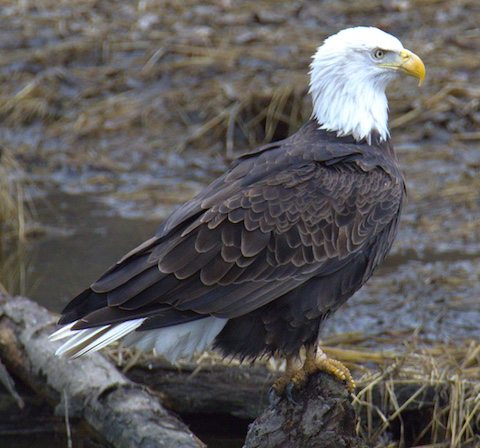
Masters of Disguise
The mature adult Bald Eagle does indeed have this classic look. But did you know that they don’t look that way until they are at least five years old? The younger birds have very different appearances from the adults from the time they fledge from the nest through their fourth year of life. The appearance of the birds changes as they molt on a yearly basis. A practiced eye can identify the age of a young Bald Eagle based on their plumage and eye and beak color. Once the eagles mature in their fifth year, their classic Bald Eagle appearance doesn’t change for the rest of their life and it’s nearly impossible to tell how old they are from outward appearances. In this month’s column, I’m presenting pictures of Bald Eagles during their first seasons after hatching, at the beginning of their second, third, fourth and fifth seasons, and finally as a full-fledged adult.
First-season (juvenile) appearance
During their first Year of life, the juvenile (first year bald eagles are called “juveniles – once they’re older but not yet mature, they’re called “subadults”) bald eagles are a very dark brown, almost black color over their entire bodies with just a very few blotches of lighter feathers. They have dark brown eyes and a large amount of black on their very large beaks. When seen in flight, they have white “wingpits” and usually intricate white markings on the underside of their wings. They also look larger than their parents as their primary feathers are longer than an adult eagles’. These longer feathers help the inexperienced eagles to more easily learn to fly and are replaced with shorter feathers after their first molt.
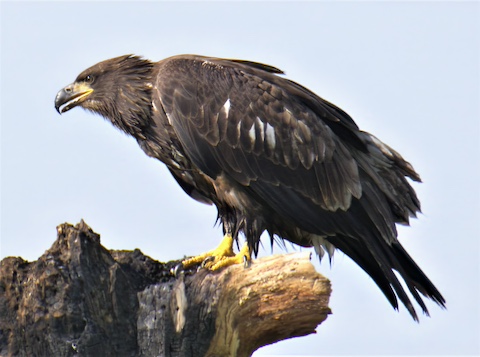
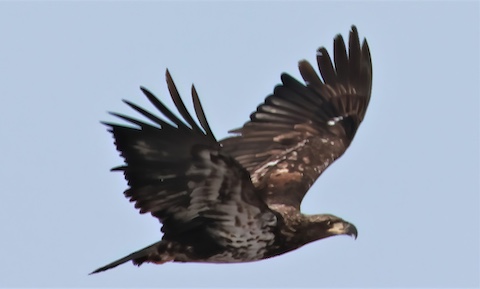
Second-season appearance
Entering their second full season of life, the subadult eagles change their appearance slightly. While still and overall brownish color, it’s usually a little lighter shade than during their juvenile year. Their eyes are still brown, and they retain their white markings in the wingpits and the underside of the wings. They also can have some blotchy white featers on their bodies where the juveniles were more uniformly dark brown.
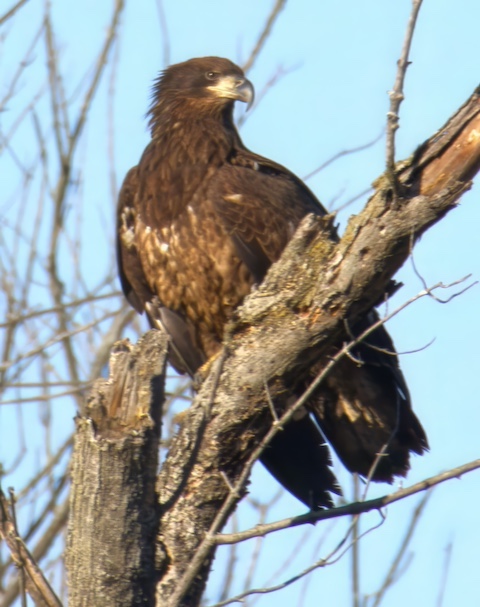
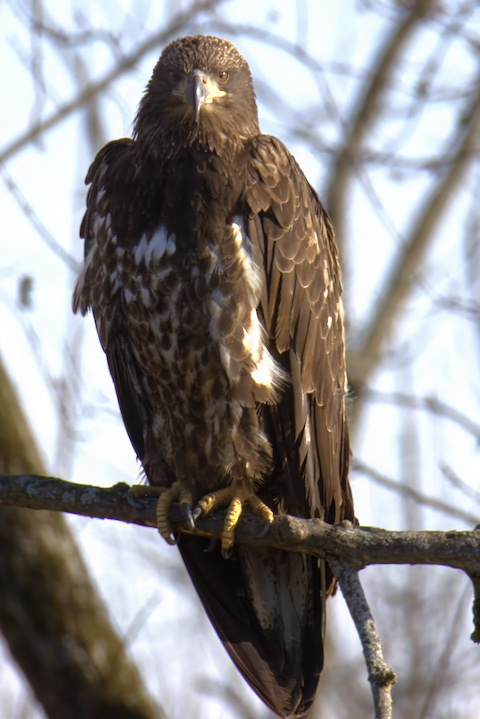
Third-season appearance
(My favorite of the subadult plumage phase!)
As they enter their third season of life, the young Bald Eagles begin to change their appearance quite dramatically. They begin to show more white plumage around their head and sometimes on their upper back. They often have a dark streak of feathers through their eye region and their eyes themselves begin to change color from a brown to a cloudy yellow. The black on their beaks becomes even less prominent and their overall look takes on a “calico-like” appearance. This stage is my favorite plumage for subadult eagles as I think they are quite attractive.

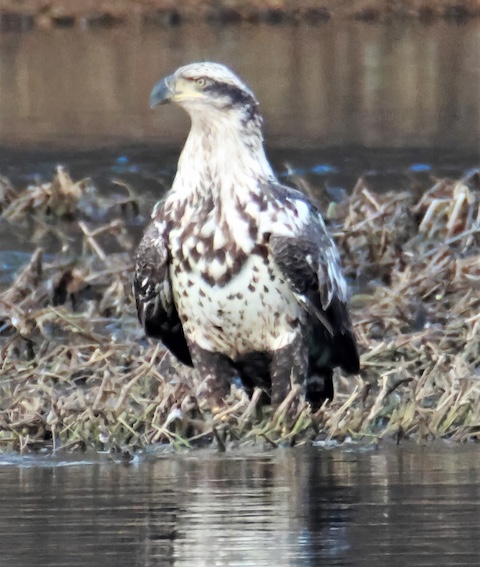
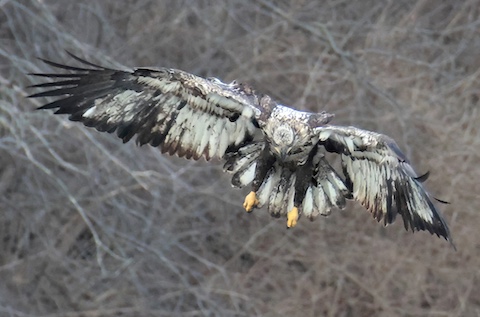
Fourth-season appearance
At the beginning of their fourth year, the young eagles begin to take on more of the characteristic adult plumage. The feathers on their head become more white streaked with grey and black and their body plumage begins to turn dark brown, but still with a number of white splotches and streaks.

The head has a little more white with quite a bit of darker plumage, and the eye color is getting to be a little lighter shade of yellow than in younger birds. The black on the beak is becoming far less prominent too.

They are really beautiful birds!
Fifth-season appearance
As the young bald eagle approaches maturity as it enters its fifth season of life, the plumage transition is almost complete. The body of the eagle becomes more uniformly dark brown with only a few white feathers interspersed among the brown and the feathers on their head become a brighter white with only a little grey or black mixed in. Their eyes become a clear bright yellow and their beaks also are a brilliant yellow with no trace of black. From a distance, it can be very difficult to tell if the bird is an early fifth year bird or a fully-mature adult eagle.
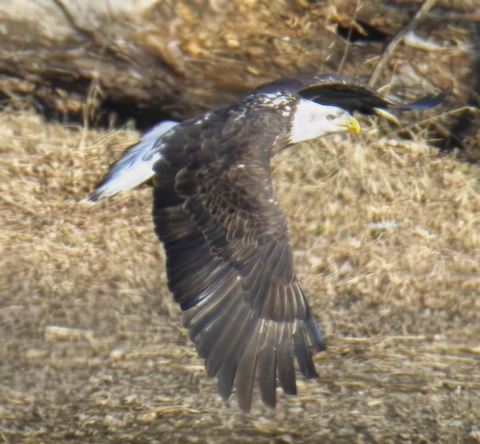
Fully mature appearance
Once the young Bald Eagle reaches the end of their fifth season of life, they acquire the classic plumage that adult eagles are well-known for. As they grow older, their outward plumage doesn’t change and it becomes very difficult, if not impossible, to tell just how old they are. Bald Eagles can live up to and perhaps beyond thirty-five years of age.
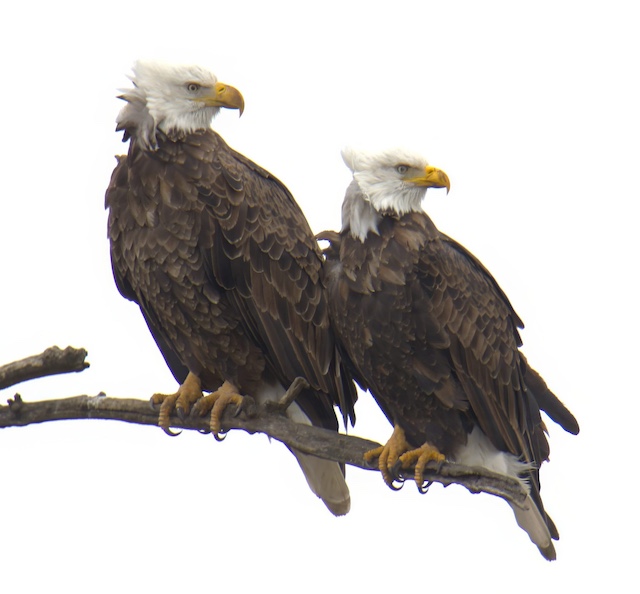
As John Denver sang in his 1972 song “Rocky Mountain High”: “I know he’d be a poorer man if he never saw an eagle fly.” Luckily, in 2024 due to the positive effects of the Clean Water Act (1972) and the outlawing of DDT (also 1972), we have many opportunities to see Bald Eagles flying along our beautiful Fox River. I hope the information provided in this column helps you to make sense of what you see when you see a large bird that you know has to be an eagle because of its size but doesn’t have the “classic” eagle appearance.
Until next time, keep on enjoying the magnificent natural wonders our beautiful Fox River Valley provides and Keep On Fixin’ the Fox!
